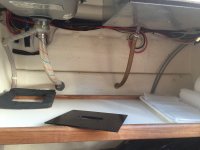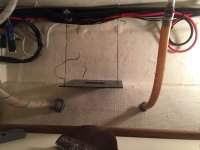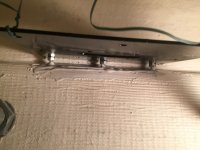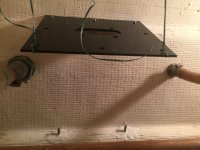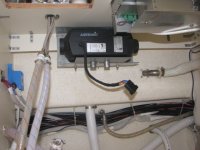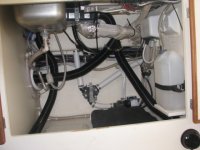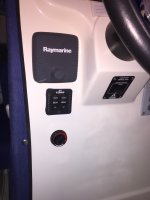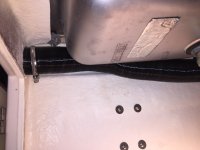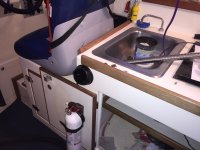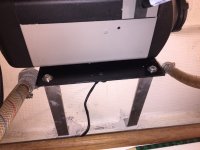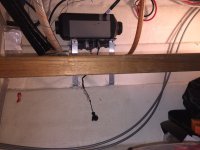colbysmith
Active member
- Joined
- Oct 2, 2011
- Messages
- 5,036
- Reaction score
- 13
- C Dory Year
- 2009
- C Dory Model
- 25 Cruiser
- Hull Identification Number
- UWH25301J809
- Vessel Name
- C-Traveler
There have been several other threads on this subject, but rather than hijacking other threads to add my installation of this heater, decided to start a new thread. I'll post as I go along, looking for any advice, suggestions or critique on my installation.
After much thought on rather or not to replace my current one burner Keynon Kiss butane stove with a Wallas combination unit, I decided to go with a heater only and leave my stove alone. (Which works well for our use.) Looking at various models, I decided to go with the Webasto Airtop 2000 ST Diesel. I was able to purchase a standard heater kit off of Ebay for $900. In speaking with a Webasto rep, I learned that the standard heater is the exact same heater also used in the Marine applications that is much more expensive. Such items as copper fuel line rather than plastic, and an enclosed fuel pump come with the marine kit. After receiving the standard kit, I also went to Sure Marine to order the Exhaust thru-hull port ($129), a side mounting bracket ($51) and an hot exhaust insulating sock ($70). Now that I've started the installation, I realize I will not need the side mount, so plan to return that. I will be ordering the plastic see through tank that Wallas uses, from Scan Marine (10L $50).
I chose to mount my heater in the cabinet directly underneath the sink, against the starboard hull. This space is unused, and the heater should not be in the way of the other stuff I store in this cabinet. My plan is to leave the cabin and combustion air intakes open, rather than running ducts to the outside. I will be installing several louver vents in the cabinet doors to allow better air circulation.
Tonight I temporarily "hung" the mounting plate in it's position, and used Loctite Marine Epoxy to glue mounting bolts to the hull. I glued 2 more bolts to the area right below, as I will then attach some fabricated brackets between this position, and the inboard side of the mounting plate.
Continuing this installation in the next day or two, plans are to put the warm output air vent just below the left (forward) corner of the sink. Not sure where I'll mount the rheostat yet. I will mount the fuel tank in the bottom of the compartment either forward or aft, haven't decided which yet, but aft makes more sense with out the fresh water lines, or shift linkage in the way.
After much thought on rather or not to replace my current one burner Keynon Kiss butane stove with a Wallas combination unit, I decided to go with a heater only and leave my stove alone. (Which works well for our use.) Looking at various models, I decided to go with the Webasto Airtop 2000 ST Diesel. I was able to purchase a standard heater kit off of Ebay for $900. In speaking with a Webasto rep, I learned that the standard heater is the exact same heater also used in the Marine applications that is much more expensive. Such items as copper fuel line rather than plastic, and an enclosed fuel pump come with the marine kit. After receiving the standard kit, I also went to Sure Marine to order the Exhaust thru-hull port ($129), a side mounting bracket ($51) and an hot exhaust insulating sock ($70). Now that I've started the installation, I realize I will not need the side mount, so plan to return that. I will be ordering the plastic see through tank that Wallas uses, from Scan Marine (10L $50).
I chose to mount my heater in the cabinet directly underneath the sink, against the starboard hull. This space is unused, and the heater should not be in the way of the other stuff I store in this cabinet. My plan is to leave the cabin and combustion air intakes open, rather than running ducts to the outside. I will be installing several louver vents in the cabinet doors to allow better air circulation.
Tonight I temporarily "hung" the mounting plate in it's position, and used Loctite Marine Epoxy to glue mounting bolts to the hull. I glued 2 more bolts to the area right below, as I will then attach some fabricated brackets between this position, and the inboard side of the mounting plate.
Continuing this installation in the next day or two, plans are to put the warm output air vent just below the left (forward) corner of the sink. Not sure where I'll mount the rheostat yet. I will mount the fuel tank in the bottom of the compartment either forward or aft, haven't decided which yet, but aft makes more sense with out the fresh water lines, or shift linkage in the way.

